2025 Meeting
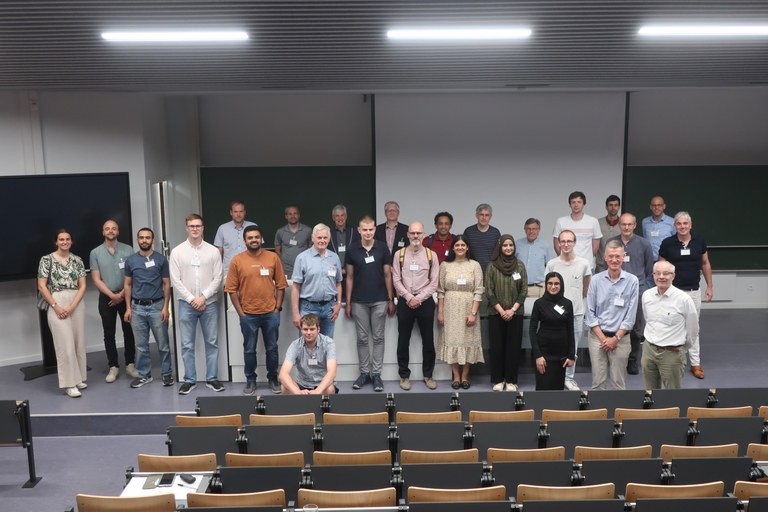
The participants of the Dutch-Flemish Scientific Computing Societies (SCS) Springmeeting at the Hasselt University in 2025.
This years Springmeeting took place on Friday 13 June 2025, at the Hasselt University. A mix of junior and senior researchers presented their research.
Location:
Sorin Pop (Hasselt University), Jason Frank (Utrecht University) and Martine Anholt (CWI, Secretary SCS).
Program
| 09:30-10:00 | Registration, coffee and tea |
| 10:00-10:30 | Jochen Schuetz: Convergence acceleration for multiderivative SDC schemes |
| 10:30-11:00 | Matthias Schlottbom: On accelerated iterative schemes for neutron transport using residual minimization |
| 11:00-11:25 | Wouter van Harten: Distributed preconditioning for the Helmholtz equation |
| 11:25-12:00 | Coffee and tea break in Wintertuin |
| 12:00-12:25 | Florian Feppon: Stokes flows in semi-infinite periodic strip |
| 12:25-12:50 | Sanjana Verma: Design of Freeform Imaging Systems: Mathematical Model and Numerics |
| 12:50-13:00 | Group picture |
| 13:00-14:00 | Lunch in Wintertuin |
| 14:00-14:25 | Karel van Bockstal: Numerical algorithms for the reconstruction of space-dependent sources in thermoelasticity |
| 14:25-14:50 | Syver Agdestein: Learning model-data consistent closure models in large-eddy simulation |
| 14:50-15:20 | Coffee and tea break in Wintertuin |
| 15:20-15:45 | Koondi Mitra: Robust & adaptive iterative linearization methods for nonlinear elliptic problems |
| 15:45-16:25 | Barry Koren: Machine Learning and Reduced Order Modeling for Uncertainty Quantification in Nonlinear PDE Problems |
| 16:25-16:30 | Closing + drinks afterwards in Wintertuin |
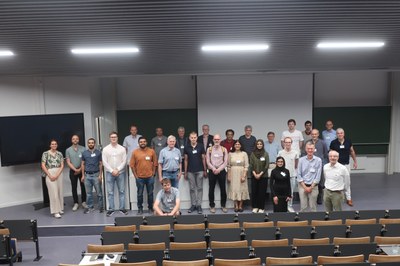
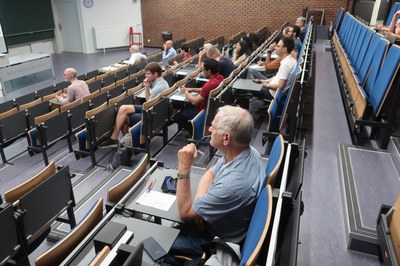


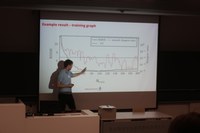




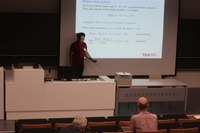

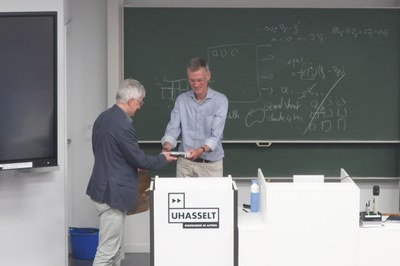

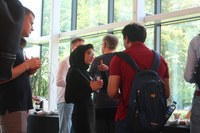


More pictures can be found here.
Speakers:
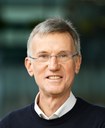 |
Barry Koren, Technical University Eindhoven Barry Koren received his MSc degree in aerospace engineering and his PhD degree in numerical mathematics, both from TU Delft. Prior to his appointment at TU Eindhoven (TU/e), he was part-time full professor Numerical Analysis at Leiden University, part-time full professor Computational Fluid Dynamics at TU Delft, and leader of the research group Modelling, Analysis and Simulation and member of the management team of the Centrum Wiskunde & Informatica (CWI) in Amsterdam. |
 |
Matthias Schlottbom, University of Twente |
 |
Jochen Schuetz, Hasselt University
Jochen Schütz is associate professor (hoofddocent) at UHasselt. He started as an assistant professor (tenure track) at UHasselt back in 2016, after having obtained a PhD (2011) and done a postdoc (2012-2015) at RWTH Aachen University. His research expertise is in high-order schemes for ordinary and partial differential equations. He has contributed to the (hybridized) discontinuous Galerkin methods for compressible Navier-Stokes equations, asymptotically preserving schemes, multiderivative time integration schemes, and many more. Amongst other things, he is co-organizer of the Belgian “Mathematics for industry week” (https://be-maths-in.be/mfi25/). |
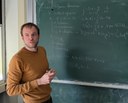 |
Karel van Bockstal, Gent University
Karel Van Bockstal obtained his PhD (in mathematical engineering) in 2015 at Ghent University, Belgium, and is currently working as a postdoctoral researcher at the Ghent Analysis & PDE Center of Ghent University (Department of Mathematics: Analysis, Logic and Discrete Mathematics). His area of specialisation is related to mathematical analysis, evolutionary partial differential equations, and the development and implementation of numerical algorithms. This research focus concerns direct and inverse problems finding applications in diverse fields such as heat transfer, elasticity, electromagnetism and thermoelasticity. He (co-)authored 39 publications, co-supervised 2 PhD students (1 finished, 1 in progress) and was awarded the EAIP Young Scientist Award in May 2016. |
 |
Florian Feppon, KU Leuven Florian Feppon is a tenure-track assistant professor at the Department of Computer Science of KU Leuven since October 2022. He is a member of the Numerical and Applied Mathematics research Unit (NUMA). He teaches courses on numerical simulation of differential equations and nonlinear systems in the Master of Mathematical Engineering program. Before joining KU Leuven, he was a Hermann–Weyl postdoctoral instructor at the Seminar for Applied Mathematics (SAM) at ETH Zürich, Switzerland, from September 2020 to September 2022, in the group of Prof. Habib Ammari. From January to August 2020, he held a postdoctoral researcher position at the Centre de Mathématiques Appliquées (CMAP) at École polytechnique, Palaiseau, France. Florian Feppon completed his PhD at CMAP, École polytechnique, from April 2017 to December 2019, supported by CIFRE industrial research funding from SAFRAN. His doctoral research, supervised by Prof. Grégoire Allaire, focused on the shape and topology optimization of multiphysics systems. He currently supervises 3 PhD students, including two as a promotor and one as a co-promotor. |
 |
Koondi Mitra, Eindhoven University of Technology Kondanibha (a.k.a. Koondi) Mitra is an Assistant Professor at Eindhoven University of Technology (TU/e), specializing in Computational Illumination Optics within the Department of Mathematics and Computer Science. Koondi completed a dual degree (B.Tech and M.Tech) in Mechanical Engineering at the Indian Institute of Technology (IIT) Kharagpur, graduating in 2015. He earned his doctorate jointly from TU/e and Hasselt University in Belgium with a cum laude distinction. Then he completed successive post-docs in TU Dortmund, INRIA Paris, Radboud University Nijmegen, and Hasselt University, before joining Eindhoven as a faculty in Nov 2023. Koondi's research encompasses nonlinear partial differential equations, mathematical modelling, applied and numerical analysis. It is focused on optics, porous media flow problems and mathematical biology. |
 |
Syver Agdestein, CWI
I am currently doing a PhD in the Scientific Computing Group at Centrum Wiskunde& Informatica in Amsterdam. My field of research is discretization and machine learning for turbulence modeling and large-eddy simulation. I enjoy bouldering,playing the piano, writing differentiable solvers in Julia, and running largefluid simulations on GPUs.
|
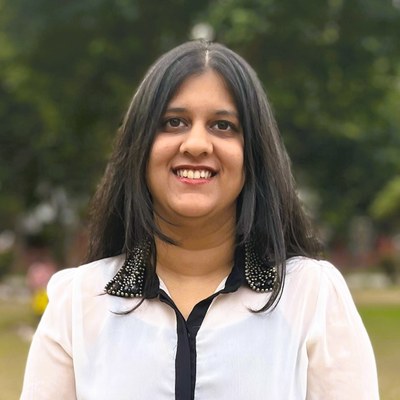 |
Sanjana Verma, Technical University Eindhoven Sanjana Verma obtained a Master’s degree in Mathematics from Indian Institute of Technology Bhubaneswar. Since September 2021, she is a Ph.D. student in the Computational Illumination Optics group at the Department of Mathematics and Computer Science, Eindhoven University of Technology. Her research focuses on developing inverse methods for the design of imaging optical systems. |
 |
Wouter van Harten, Radboud University After obtaining a MSc degree in Applied Mathematics at the University of Twente, Wouter van Harten started his PhD research project at the Radboud University in late 2021 under the supervision of Laura Scarabosio. His research is focussed on high dimensional uncertainty quantification, with a specific interest in uncertainty in the domain of a Partial differential equation and computational approaches. |
Abstracts:
|
